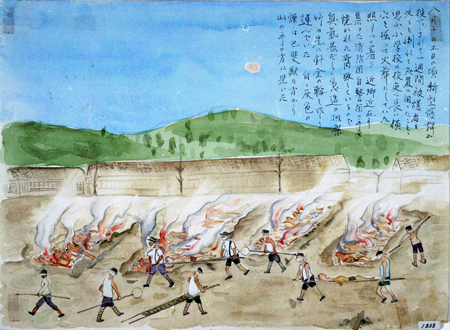Memoir of the A-bombing
An 8-year-old's memory of Hiroshima
Teruko Yahata
Atomic Bomb Witness for this Foundation

Final stages of Pacific War
I was 8 years old when the atomic bomb was dropped.I had started at Hiroshima Municipal Koi National School the previous year. When I passed through the school gate the cherry blossom trees were in full bloom, and the petals flew around, turning the school ground a pale pink color. Around that time, when we turned on the radio, we would hear a strong voice saying "Announcement from Imperial General Headquarters! We have sunk the enemy's aircraft carrier. Japan did not sustain major damage."
However, the war situation gradually worsened. After the morning assembly in the school yard, the senior students marched, singing "With our swords we will give our lives to kill one hundred, one thousand." They were determined to fight on Japanese soil, believing that Japan would definitely win the war.
August 6: Under the mushroom cloud
On that day, the sky was clear and it was a fine morning.
At my home in Koi-hon-machi, 2.5km from the hypocenter, were my great-grandmother on my father's side, my grandmother, my parents, my older sister, me, and my two younger brothers―a total of eight people.
After breakfast, it was just when I had gone to the back garden to go to the house next door.
Suddenly, the window flashed with a pale light.
I immediately dropped to the ground, and lost consciousness.I was awoken by my mother’s voice yelling "Everyone gather here!" I was surrounded by dust so thick that I could not see anything around me. Inside the house, everything had collapsed, and there were countless pieces of glass of the shattered corridor windows stuck into the fallen fusuma screen. I had been thrown from the back garden to the front of the house, a distance of about five or six meters. "Let's all die together! Everyone is together," my mother desperately cried as she covered the family members who had gathered with a large comforter. She thought that if a second or third bomb was dropped, we would not survive. I remember the warmth of family at that time, as we sat shoulder to shoulder under the comforter: the family connection that I felt at that time as a child is something that I remember even today.
Outside, houses were half collapsed, and it was eerily quiet. We fled to the foot of a nearby mountain, but then large drops of rain began to fall, and we all got soaking wet. There was no way that we could have known that this was 'black rain'. Eventually, we returned to the riverside in Koi. On the way, I was frozen by the sight of the people fleeing from the city. Their hair was standing on end, they were suffering from serious full-body burns, they were covered in dirt, and the skin from their arms had peeled away and was hanging from their limp fingertips like rags. Dozens, hundreds of people dragged their burnt bodies along; they were like a procession of ghosts. The city continued to burn throughout the night.
August 9: Schoolyard turned into a cremation site
Although some of my family members were injured, we all survived.
I had a wound on my forehead, so my father took me to the aid station at the school.
When we went through the school gate, we heard a murmur of voices that was neither crying nor groaning.The classrooms and the hallways were filled with seriously injured people lying there. The faces were blistered, and everyone had their eyes closed. People who had died were carried on stretchers to the sports ground, where they were thrown into many holes that had been dug there, and cremated. In the heat of mid-summer, the rising flames from the cremations produced heat haze around the fires, and the people silently working there appeared to waver in the haze. The school was filled with the strange odor from the billowing smoke.
Precious life
In 2013, I participated in the Peace Boat Hibakusha Global Voyage.
We are all born on this large planet Earth, and even if our countries and languages are different we are all living in the same era.
In the one hundred years of a person's life, we experience daily life that is irreplaceable, like the sun rising and setting and the waves coming in and going back out.
Who is important to you? What do you want to protect?
If a nuclear bomb was used now, humankind would be wiped out.
What I can do is to continue to communicate the reality of the atomic bombing, send out warning bells to the global community, and live in the present.
Profile [Teruko Yahata]
In 2013, consigned by the Ministry of Foreign Affairs as Ambassador for Denuclearization.
Participated in the Peace Boat Hibakusha Global Voyage.
Started activities as an atomic bomb witness for the Hiroshima Peace Culture Foundation in 2019.
Started activities as an atomic bomb witness for the Hiroshima Peace Culture Foundation in 2019.
Hiroshima Peace Culture Foundation
1-2 Nakajima-cho, Naka-ku, Hiroshima 730-0811 JAPAN
TEL +81-82-241-5246
Copyright © Since April 1, 2004, Hiroshima Peace Culture Foundation. All rights reserved.
